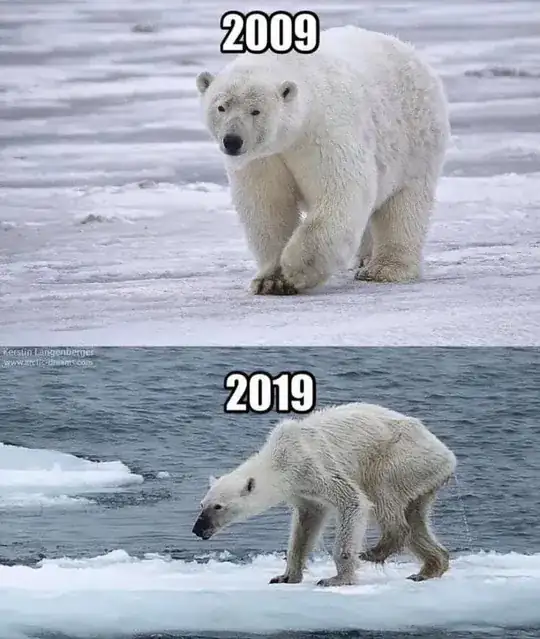I am aware that it may be difficult to find much evidence around these photos.
They are, actually, irrelevant to the question as summarized by you on request. The pictures are meant to be illustrative; criticising the second picture for e.g. giving the "wrong" year is attacking a straw man.
(For completeness, I am addressing your questions about the picture at the end of this answer, anyway.)
It would be interesting to know if the average weight of polar bears has reduced in the last 10 years
Yes.
From Wikipedia: Polar bears # Climate change, emphasis mine:
The effects of climate change are most profound in the southern part of the polar bear's range, and this is indeed where significant degradation of local populations has been observed.[182] The Western Hudson Bay subpopulation, in a southern part of the range, also happens to be one of the best-studied polar bear subpopulations. [...]
Due to warming air temperatures, ice-floe breakup in western Hudson Bay is currently occurring three weeks earlier than it did 30 years ago, reducing the duration of the polar bear feeding season.[163] The body condition of polar bears has declined during this period; the average weight of lone (and likely pregnant) female polar bears was approximately 290 kg (640 lb) in 1980 and 230 kg (510 lb) in 2004.[163]
Source [182] is:
- Arctic Climate Impact Assessment (2004). Impact of a Warming Arctic: Arctic Impact Climate Assessment: Key Finding 4. Cambridge: Cambridge University Press. ISBN 978-0-521-61778-9. OCLC 56942125..
Source [163] is:
- Stirling, Ian; Derocher, Andrew E. (2007). "Melting under pressure: The real scoop on climate warming and polar bears" (PDF). The Wildlife Professional (published Fall 2007). 1 (3): 24–27, 43.
I don't think there is reason to believe that this is offset by an increase of 20% in body weight in other regions (lacking any plausible increase in living conditions).
As for your questions about the image in particular:
2019 has only just begun. It seems a little unlikely that the image of the polar bear was taken in the last 15 days (but not impossible, of course)
It was not taken 2019, but in 2015. The idea of the "2019" / "2009" given in the picture is not, however, to claim that those were the years in which the pictures were taken. As stated in the FB post ("The 10 years challenge we should really care about..."), the idea was to illustrate the worsening situation of polar bears (and probably climate change in general), *in context of the "10 year challenge". The "2019" is today, the "better" 2009 (to illustrate that the situation is worsening) is just "10 years back from right now".
The second polar bear appears to have just emerged from water (drops coming from its tail?). This can often cause fur to clump (it happens to my dog when he is bathed). Is this causing a lot of the difference?
An image search for "wet polar bear" shows a wide range of results, with the specimen pictured under "2019" definitely being on the emaciated side. Yes, wet fur makes a difference -- but not that much.
Were the images taken at different times of year? I believe that polar bears hibernate. It could be that the first polar bear has been eating, storing up fat for the winter period, and the second has just left hibernation.
Polar bears are not true hibernators. But even a healthy female bear just out of "hibernation", being wet does not look like the specimen in the "2019" picture.
Is the image of the same polar bear? I’m fairly confident it isn’t - hence I’ve taken it to be a comparison of the typical bear then and now.
It's nowhere claimed that it's the same bear. The life expectancy of a wild polar bear rarely exceeds 20 years.
